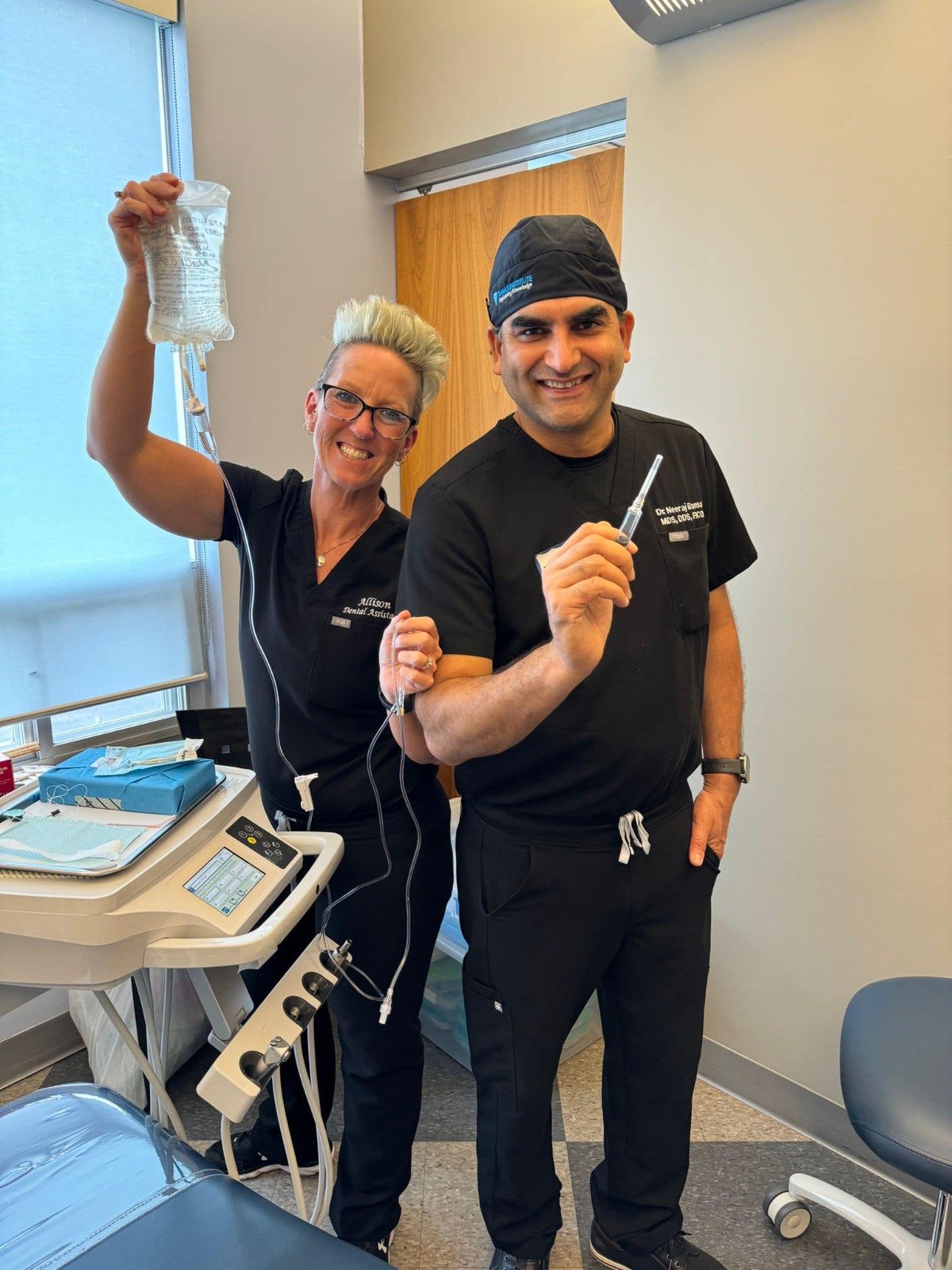Bonding
Composite bonding can work wonders for your smile. Using materials that match the shade, translucency and the texture of your teeth, gaps between teeth can be closed, spots and discolorations can be eliminated, and your self-confidence can be enhanced through the improved appearance of your smile.
Our dentists will match the shade of your existing teeth and then tooth-colored composite resin is applied to the tooth much like the filling procedure.
The procedure is sometimes referred to as bonding because an adhesive agent is used to actually bond the resin to the tooth structure.
The resin is hardened (cured) with a curing light and then shaped, contoured, and polished to give a cosmetic and natural appearance. Bonding is the least expensive cosmetic procedure and can be completed during a single dental visit.
Composite bonding is excellent for small defects in the teeth -- spots, chips, or gaps between teeth. For smile alterations involving an entire tooth or multiple teeth, porcelain is the material of choice.
Wisdom Teeth
Wisdom teeth are the upper and lower third molars, located at the very back of the mouth. They are called wisdom teeth because usually they come in when a person is between 17 and 21 years or older-old enough to have gained some "wisdom." Wisdom teeth that are healthy and properly positioned do not cause problems.
Wisdom teeth may break partway through your gums, causing a flap of gum tissue to grow over them where food can become trapped and a gum infection can develop. Wisdom teeth can also come in crooked or facing the wrong direction. Or, if your jaw is not large enough to give them room, they may become impacted and unable to break through your gums. You may have trouble properly cleaning around wisdom teeth because they are so far in the back of your mouth and may be crowded.
What are the symptoms of wisdom teeth problems?
Wisdom teeth often cause no symptoms. Symptoms that may mean your wisdom teeth need to be removed include:
Pain or jaw stiffness near an impacted tooth.
Pain or irritation from a tooth coming in at an awkward angle and rubbing against your cheek, tongue, or top or bottom of the mouth.
An infected swelling in the flap of gum tissue that has formed on top of an impacted tooth that has partially broken through the gum.
Crowding of other teeth.
Tooth decay or gum disease if there's not enough room to properly care for the wisdom tooth and surrounding teeth.
Most problems with wisdom teeth develop in people between the ages of 15 and 25. Few people older than 30 develop problems that require removal of their wisdom teeth.
Your dentist will examine your teeth and gums for signs of a wisdom tooth coming through your gum or crowding other teeth. You will have X-rays to find out whether your wisdom teeth are causing problems now or are likely to cause problems in the future.
Treatment
The most common treatment for wisdom tooth problems is removal (extraction) of the tooth. Experts disagree about whether to remove a wisdom tooth that is not causing symptoms or problems. Oral surgeons generally agree that removing a wisdom tooth is easier in younger people (usually in their early 20s), when the tooth's roots and the jawbone are not completely developed. In the late 20s and older, the jawbone tends to get harder, and healing generally takes longer."
Crowns & Bridges
Dental crowns and bridges fit over injured, discolored, or cracked teeth or fill the space resulted after dental extractions and protect the teeth from further injuries or damages helping also to the prevention of any toothaches or discomfort you may experience. We are well known in Perth for our expertise with Dental Crowns and Bridges.
Emergency Services
Dentistry@Almonte operates emergency services for our patients. Contact us at in case of an emergency.
We see Emergencies Same-Day!
Extractions
Dental extractions are performed for a wide variety of reasons. Tooth decay that has destroyed enough tooth structure to prevent restoration is the most frequent indication for extraction of teeth. Other indications are related to impacted or problematic wisdom teeth and also to make space for orthodontic treatment in some particular cases
Fillings
Modern dentistry has allowed Dentistry@Almonte to combine beauty as well as strength when filling teeth. Restorations are close to their original strength and appearance with composite resins and other modern materials. The patient’s comfort is always the main priority of the dental team, leading to a positive experience.
Fillings (restorations) are used to replace tooth structure that is decayed. Caries can be detected through direct observation or x-rays. Fillings are also used to repair fractured, broken, or severely worn teeth.
Implants
Implants are indicated whenever at least one tooth is missing. If the missing space(s) is not filled, the teeth surrounding the space often drift, the opposing teeth in the other arch will erupt further into the oral cavity (hypereruption) which can change your bite, bone erosion can occur in the area, and even changes in speech might occur. The popularity of implants has increased steadily over the years.
Oral Surgery
Oral Surgery is the specialty of Dentistry @ Almonte; it includes the diagnosis, surgical and related treatment of diseases, injuries and defects involving both the functional and aesthetic aspects of the hard and soft tissues of the head, mouth, teeth, gums, jaws and neck.
Periodontal Therapy
Periodontal or gum disease is an infection of the tissues that surround and support your teeth. It is a leading cause of tooth loss in Canadian adults. Good oral hygiene and regular dental examinations are essential in prevention and early detection of gum disease – which sometimes developing without any warning signs.
The inflammation and infection of gums, ligaments, bone, and other tissues surrounding the teeth. Gingivitis (gums disease) and periodontitis (gums and bone disease) are the two main forms of periodontal disease also called gum disease or pyorrhea.
Periodontal disease is an infection of the tissues that support your teeth. Periodontal disease, also known as gum disease, is one of the most common infections today. More than 75% of North Americans over 35 years of age have some form of periodontal disease. Although many are infected, few know they actually have the disease. In a recent study, 8 out of 10 people surveyed believed they did not have periodontal disease, 7 out of 10 exhibited one or more symptoms.
Root Canal Treatment
Root canal therapy is an indispensable procedure in treatment of teeth that are severely decayed, infected, or broken. Root canal therapy can maintain your teeth life for more years, saving them from extraction.
Tooth Whitening
In-office treatment can brighten your teeth by six to ten shades. Using a special, light-activated whitening gel, this procedure is a quick and convenient way to achieve the smile you've always wanted.
Tooth whitening is a procedure that can lighten the shade of your teeth and remove stain or discoloration caused by ageing, certain medications, tobacco, coffee, and tea. Tooth whitening will not last forever, so the procedure will have to be repeated on a regular basis.
Tooth whitening can be done at home or in the dental office. Dr. Bansal, Dr. Kapur, Dr. Sandhu and Dr. Patel will often take a photo of your existing tooth colour to monitor your progress and compare the new lighter shade of your teeth throughout treatment.
Scaling & Root Planing
Plaque is a sticky substance that adheres to tooth structure and is teeming with bacteria. Over time, plaque becomes calcified (hardens) and at this stage, it becomes what is called calculus. Plaque and calculus are actually irritants to the tissues of your mouth. The reaction of your body to the irritants and the subsequent gum inflammation, gum recession, bleeding and eventual bone loss around the teeth constitute periodontal (gum) disease. The earliest stage of periodontal disease is called gingivitis (which is reversible) and is characterized by bleeding gums, especially when one brushes and flosses. If the disease is not addressed, it will progress to periodontitis, which is far more destructive, and is characterized by further gum deterioration, bone loss, and ultimately tooth loss.
Scaling and root planing are the most common form of treatment for periodontal disease. Scaling removes calculus (also called tartar) and plaque from the tooth surface above and below the gum line. Root planing improves smoothness of the root's surface and removes any remaining calculus. When the amount of plaque and calculus to remove is extensive, the dentist will numb the area to make the procedure comfortable for you. A combination of sonic and hand instruments are used in the procedure. The sonic instruments remove the large deposits of plaque and calculus. Hand instruments are then used to remove any remaining tartar and ensure all surfaces of the crown and root are clean and free of bacteria. Sensitivity and soreness may be present a few days following treatment and usually can be relieved with over-the-counter pain relievers.
Veneers
Veneers are routinely used to cover teeth which are discolored, worn, chipped, or misaligned. Veneers are used for many of the same reasons as bonding but they involve a different procedure. If you are looking for a dentist in Renfrew to find a solution for worn or misaligned teeth, give Dentistry @ Almonte a call and our dentists can help you find an affordable solution such as Veneers.
IV Sedation
If you avoid visiting the dentist because you fear dentists, dental pain, or dental tools, we can help. We offer IV sedation dentistry as a secure and efficient means of promoting patient comfort and relaxation throughout dental treatments. When our skilled nurse administers the IV sedation, patients are awake but extremely calm, with little to no recall of the treatment. This option is ideal for those who experience dental anxiety, require extensive treatment, or simply prefer a more comfortable experience.
This service is currently offered exclusively by our affiliate office, Dentistry @ Renfrew.
Benefits of IV Sedation Dentistry:
Relaxation and anxiety relief.
Little to no recollection of treatment experience.
Can complete more dental work in fewer visits.
Fewer side effects compared to other sedation options.
Dentistry @ Almonte is ready to help restore your smile’s health, appearance, and function accompanied by the relaxing effects of IV sedation. Contact us today to learn how IV sedation dentistry can help with the completion of your dental treatment.
Inquire about an Appointment
Welcome to the online style of booking your appointment online. Simply click the inquire button below and see how easy the process is!
















